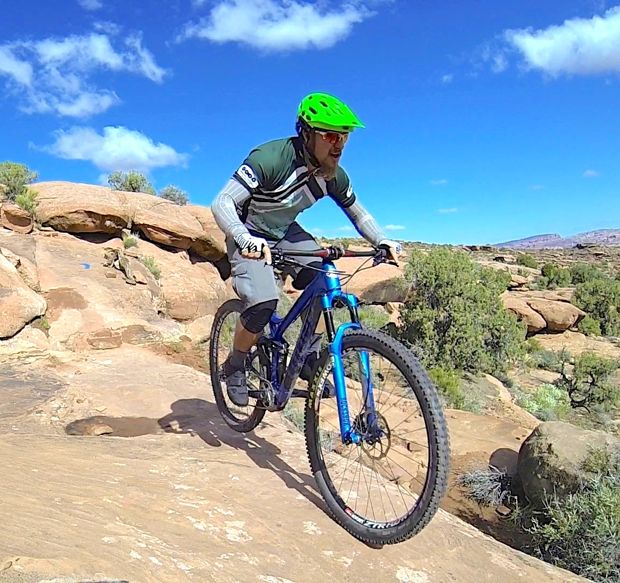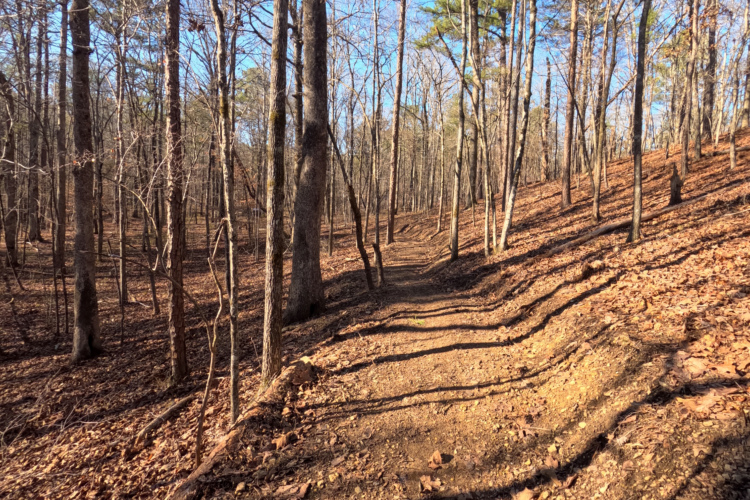Having earned a coveted spot on our list of the 5 Most Innovative Mountain Bikes of 2016, I knew that I had to get on the Pivot Switchblade to see if the bike could stand up to the hype.
The Switchblade gets its name from the ability to quickly and easily swap between 27.5+ and 29″ wheels and tires. I opted to test the bike in the 27.5+ mode, natch’.
Specs
Somehow I weaseled my way onto a brand-new, never-been-ridden top-tier build specced with a Shimano XTR 1×11 mechanical drivetrain, Reynolds Carbon 27.5+ wheels (40mm internal), a Fox 36 Factory Kashima fork up front with 150mm of travel, Fox Float Factory DPS Evol Kashima shock in back (135mm of travel), Fox Transfer dropper post, a Pivot-branded cockpit with carbon bars, and Maxxis Rekon 2.8″ tires.
The Switchblade’s geometry is right in line with many modern trail bikes, with a 67.25-degree head tube angle and 428mm chainstays (more on that below). As always, Pivot offers exceptional clearance for short riders, with an XS size frame that offers a 26.8″ standover height.
Of course, the Switchblade has a full carbon frame with all of the latest tech, including Pivot’s proprietary rear hub spacing, dubbed “Super Boost.” Basically, Super Boost utilizes existing 157mm DH hub spacing, but Pivot worked with DT Swiss, Industry Nine, and Reynolds to develop specific Super Boost hubs that move the flanges out even further than Boost 148 or standard DH 157 hubs, thereby creating an even stiffer wheel.
If you’re confused on the differences, don’t worry–here’s a handy chart to help clear things up:
Despite having a really wide rear end with clearance for full 3.25″-wide plus tires, the chainstays on the Switchblade are astonishingly short–16.85″, or 428mm. Not only that, the Switchblade is also compatible with a front derailleur and 2x drivetrains. Keep reading for more on why this rear end is so exceptional, and why some other bike companies are lying to us.
Out on the Trail

From the initial climb right out of the demo center, I found the Switchblade to fly up the hill in spite of the plus tires and long travel fork. Pivot is known for making bikes that pedal superbly, even in their long-travel models, and the Switchblade is no exception to that rule. Pedaling hard up the dirt road and accelerating up and over rocky ledges were both a dream. To truly test the pedaling platform, I left the suspension full-open, and I still found it to be spry and snappy. For an even firmer pedaling platform, the Fox shock offers a full lockout.
Turning back down the mountain, the 135mm of rear travel and 150mm of front suspension were more than ample forgiveness for the rocky, ledgy terrain found in Bootleg Canyon. Add in the plus wheels, and this trail bike offers more than enough cush and forgiveness to not only serve as an everyday rider, but pull double duty as an enduro race bike on certain courses. We’re seeing many enduro racers forgoing super long travel enduro rigs in favor of shorter travel bikes that are lighter and pedal faster, and the Switchblade fits that model perfectly.

In short, while I only got a 6-mile ride in on the Switchblade, I can already tell this is a bike that I could easily ride all day, every day. It pedals much more capably than my own personal enduro bike, and yet sacrifices little in descending prowess. I may be in love.
When I arrived back at the tent, Carla McCord, Pivot’s chief marketing guru, asked “could you feel the Super Boost?” And I responded that honestly, after a mere 6-mile ride with no A/B comparison, there’s no way I could tell exactly what the Super Boost was or was not doing for the bike. I could feel that the bike was very laterally stiff in the rear end, but there are so many variables that play into that feeling, including the stiff Reynolds carbon wheels, the frame design, suspension linkage, tires, tire pressure, and yes, the design of the rear hub. However, I did notice other interesting attributes about the design of the Switchblade’s rear end from my short ride…
The Switchblade’s Rear End Means Some Other Brands Are Full of BS
As you can tell, I had a great time aboard the Switchblade! And best of all? I had zero calf-bang on the frame.
Over the years, I’ve heard justifications from a variety of brands about the compromises that they supposedly “had” to make in order to fit plus-size tires in the frame. Painful banging of the calves on the frame? “Oh, the tire wouldn’t fit without that clearance.”
No 2x compatibility? “Not enough clearance.”
Chainstays too long? “Needed clearance to fit a front derailleur.”
Ugly elevated chainstays? “Required to get the chainstay length short enough.”
Tire clearance in the stays too tight? “Trying to avoid calf-bang.”
Basically, every brand has a line of BS for why they had to make some compromise to provide a different attractive feature. But you know what? Pivot has successfully fit everything they needed into the rear end of this bike, without making any compromises.
There’s zero calf bang. The chainstays are short, even compared to some hardtails. The rear end offers 135mm of suspension travel. The stays can clear tires up to 3.25″ wide. And the bike can even run a front derailleur–one of the most common features sacrificed for plus tire, and even 29er, clearance
So what’s the tradeoff? Pivot sacrifices 3mm of Q Factor width (meaning it’s 3mm wider) compared to other comparable models in their line. But you know what? Again, their Q factor is still narrower than many other brands.
In short, the fact that Pivot accomplished so much with the rear end of this 27.5+ mountain bike with essentially zero sacrifices means that every other brand that’s said “it can’t be done,” or “this is a necessary sacrifice” is full of shit.
Bottom Line
While I only got out for a short test ride aboard the Switchblade, this brief test was an eye-opening experience. After diving deep down the rabbit hole of geometry specs and bike design, it’s clear that Pivot has created a rare beast of a mountain bike that solves many common issues with the 27.5+ wheel size without making any sacrifices. And on top of that, this bike has it where it counts: it just rides friggin’ awesome!
MSRP: $8,500


















10 Comments
Sep 28, 2016
As for bikes not being able to run 2x, I'm not really concerned. Having the bailout gear for climbing after being in the saddle all day was nice, but a 30T chainring worked pretty well with a 42T rear cog. Now that they have the dinner-plate option (50T), having a front derailleur is even less of a necessity, IMO.
Sep 28, 2016
Sep 29, 2016
Oct 1, 2016
Oct 1, 2016
Sep 29, 2016
Sep 30, 2016
Nov 14, 2016
Sep 28, 2016
Also, going from 29 to 27+ is a little more involved. Pivot recommends using a taller (17mm) lower headset cup when running the plus wheels to keep the BB from getting too low. You could always just leave the cup on at all times to make it easy to swap, but the BB height with 29" wheels would be on the high side. Not necessarily a bad thing though.
Sep 28, 2016
Good points on the difficulty to switch back and forth, I definitely didn't address that above.